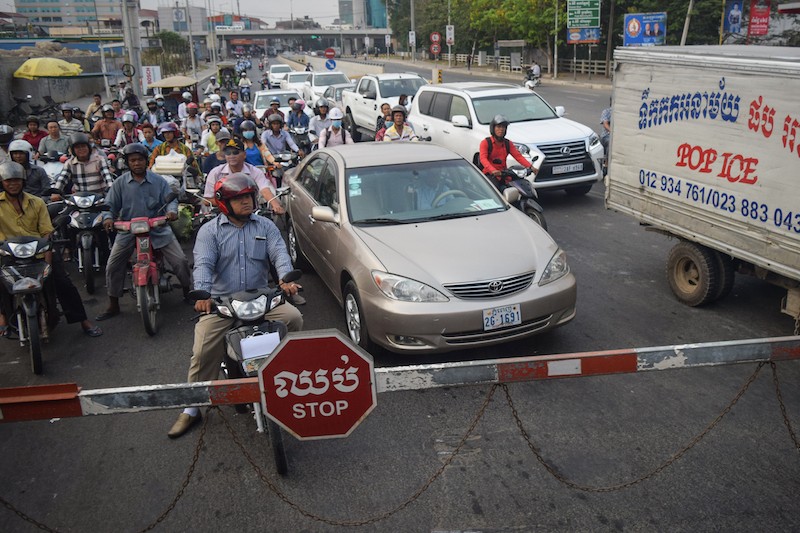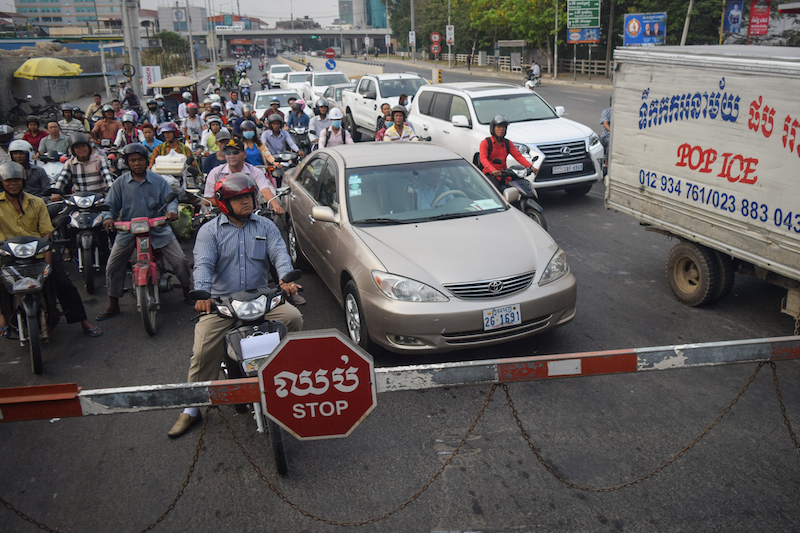Ignoring large stop signs and frantically waving villagers, a trucker turned to cross the train tracks at the entrance to a cement factory in Kampot province. Wearing headphones, he missed the repeated blasts of an approaching train, which was returning empty to Sihanoukville after delivering a load of diesel fuel.
Although the train’s engineer spotted the cement tanker from 800 meters and began applying the brakes about 400 meters out, the locomotive was unable to stop in time, and pushed the truck 80 meters along the rails.

The driver of the articulated truck, which had wrapped around the front of the train, fled the scene after causing significant damage to the locomotive and injuring its driver, Royal Railway CEO John Guiry said on Tuesday, outlining the chain of events leading up to the collision in Kampot’s Banteay Meas district last week.
Mr. Guiry said Royal Railway had requested $600,000 from Shi Mao Trading, which owns the truck, to replace the locomotive. “The driver is lucky to be alive.”
Deputy Banteay Meas traffic police chief Min Nheb confirmed on Tuesday that the driver of the cement truck, 29-year-old Bok Sarim, was being sought by police after fleeing the scene at the Chip Mong factory.
As Royal Railway increases its traffic—there are now up to 16 freight and passenger train journeys daily along the 266-km line between Phnom Penh and Sihanoukville—incidents like this are increasing, Mr. Guiry said.
The cement truck was the fifth vehicle to crash on the rail line since January, with motorists either ignoring clear signs to stop at crossings or crossing off-road where there are no signs, highlighting the need for more work in educating drivers, said Ear Chariya, director of the Institute for Road Safety.
On May 26, a van driver attempted to cross train tracks in Phnom Penh’s Pur Senchey district at a spot where cows cross, police said at the time. After a train carrying diesel fuel for local conglomerate Sokimex struck the van on the tracks, the driver fled the scene, leaving the company to shunt it off the tracks.
In Kampot province in March, a truck carrying cement attempted to cross in front of the oncoming train, causing a collision. And in April, one of the newly operating passenger trains hit an SUV in Kandal province, injuring the driver, his wife and four children. Video footage from the front of the train showed the car driver watching the approaching train and then stopping in the middle of the tracks.
Mr. Guiry said that following the resumption of freight transport between Phnom Penh and Sihanoukville in 2013, the company had invested in education and safety along the track, including handing out leaflets and sending out a trolley-car blasting a safety message along the lines of “please stay away from the line.”
A recent $2.5 million project to make official crossings easier to navigate—and therefore more likely to be used—had been undertaken because people still cross at “illegal” points, he said. Four more sets of boom barriers have been installed at larger crossings in the past two months, and 65 guards are employed at the largest crossings to help to ensure safety, he added.
But near misses with trains, and accidents involving the barriers, indicate that more needs to be done. Mr. Guiry said he had recently asked the Interior Ministry to station police officers at major crossings to help enforce the rules.
“We are trying to make it safer for everyone as we go,” he said. After a meeting with Chip Mong management on Tuesday, Mr. Guiry said they had agreed to use a different crossing for trucks entering the factory.
Mr. Chariya of the Institute for Road Safety said while it was clear that insufficient caution was being paid by those crossing the country’s rail lines, only 60 percent of car drivers are licensed, meaning that many motorists lack even the most basic road safety training.
Current laws, for example, advise drivers to stop at least 2 meters in front of crossings once a train sounds its horn.
“Education is one contributing factor that leads to people not respecting the rules. Enforcement is another. When people are not afraid of getting a punishment, they don’t mind violating the rules,” he said.
If drivers pay enough attention to the trains, “these incidents would be avoided,” he said. “The government needs to make a lot more effort in creating a culture of driving safety.”




